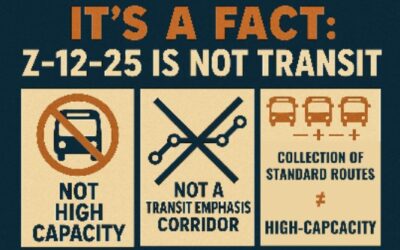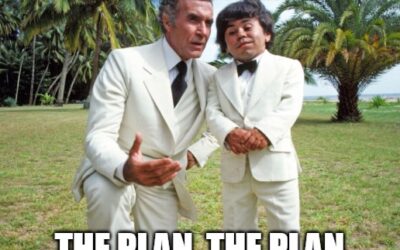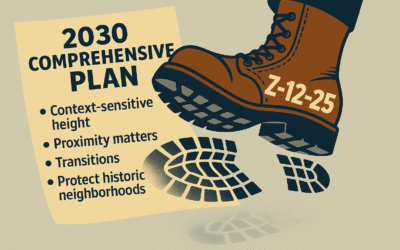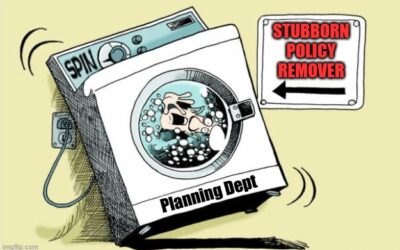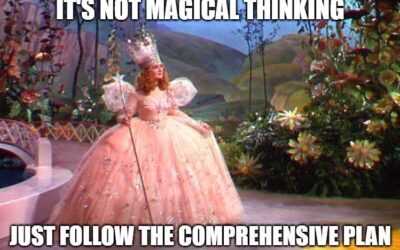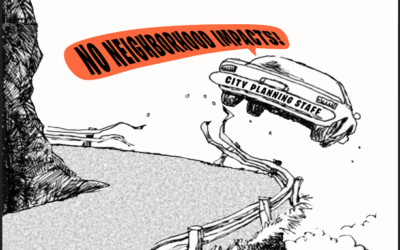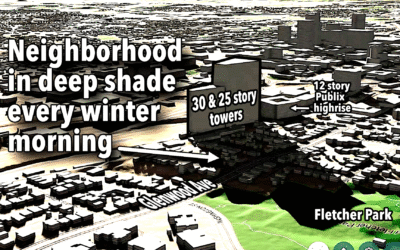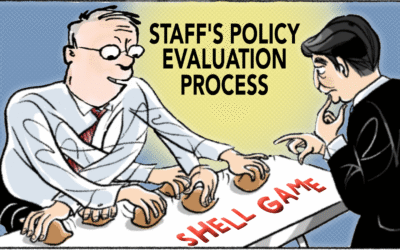For a site to be designated as a Transit Land Use category, it must meet the definition “fronting along a corridor programmed for high-capacity, frequent bus transit.” The West St site meets ONLY the frequent transit criteria but fails the other two. It does not qualify for the Transit Land Use category.
Planning Department Fantasy!
Our Comprehensive Plan says building heights should transition from the Central Business District to residential neighborhoods. The planner says 30 stories is transition. FANTASY!!
Z-12-25 Stomps on Raleigh’s Comp Plan
Raleigh has the tools and the policies to manage growth responsibly. Z-12-25 ignores them. Approving this rezoning would not only damage a historic neighborhood but also set a precedent that threatens every neighborhood in Raleigh. The Comprehensive Plan shows us the path forward: moderate, context-sensitive growth that strengthens, not undermines, our city’s future.
Honor the Process. Planning Runs Policies thru the Spin Cycle
The materials being presented by the Planning Department in support of Z-12-25 do not create a complete picture or analysis that is useful for basing your decision on this third round of change requests for these particular parcels. A good analysis of compatibility should take a broad view of relevant rules, plans and guidance, and it should reflect stakeholder input with integrity. Given the inadequacies of the materials provided to you, there is no way you can come to a rational conclusion of consistency with the comprehensive plan.
Selective Policy Emphasis and a Disregard for Neighborhood Protections
Are we just counting which policies are convenient for a project and ignoring the ones that aren’t? This isn’t about stopping growth. It’s about rejecting a project that ignores codified transition areas, disregards protections for historic neighborhoods, and offers no real public benefit for on-site affordable housing.
Why Z-12-25 (The West Street Tower) Fails Raleigh’s Vision
Raleigh needs growth, but growth must be responsible. The 2030CP and ETOD establish a framework where context, transitions, and neighborhood protection guide how and where height happens. Z-12-25 proposes 240-360 foot towers just steps from a historic neighborhood. This is inconsistent with adopted plans, sets a dangerous precedent, and undermines Raleigh’s planning tools.
It’s Not the City’s Responsibility to Insure Business Profits
In order to make important decisions with confidence, City Council needs good advice. The Planning Department should be working to provide you with a recommendation based on a full and rational analysis of all impacts, positive or negative, and consistency with the Comprehensive Plan. Their job is NOT to convince you the proposal is necessary and essential to the continued expansion of Raleigh’s revenue base.
Smashing through the Guardrails of Policy
Amazingly City Staff identified no detriments from this rezoning case. This proposed development is very close to a historic neighborhood. Why is there no reference in this document to Section 12 of the Comprehensive Plan regarding Historic Preservation? The first comment reads “Lack of transitions around historic resources which can sometimes lead to jarring juxtapositions of scale and proximity that detract from the character of the historic resource’s setting.” Has anybody read this or is even aware of this section of the Comprehensive Plan?
Making growth choices that will stand the test of time
Everyone agrees that more urban parks and walkable urban densities are good things, but promoters of 30 story towers next to the historic Glenwood Brooklyn neighborhood have offered no evidence that the new 12 story Publix building just across Peace Street isn’t an excellent example of what could go on the West Street site, giving the developer ample profits and urban high-rise densities without casting 30 story shadows over the neighborhood every winter morning
A Flawed Foundation for Deliberations
Staff reports carry weight in Planning Commission and City Council deliberations. When they misclassify sites, turn a blind eye to policies, minimize area plans, and claim no adverse effects, they create the illusion of consistency where none exists and inflate the benefits while minimizing impacts. This clearly affected the Planning Commission deliberations and stunted debate necessary to make an informed decision.

